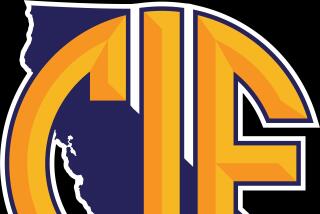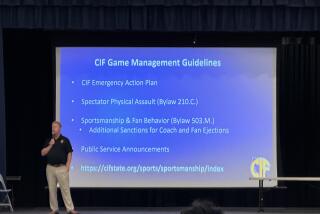They Are Already Looking Toward â92 NCAA Convention : College sports: Division I-A football schools get a larger say in their financial aid.
NASHVILLE, Tenn. â The harmonious 85th annual NCAA convention ended Thursday with schools taking more action to change the face of Division I and sending signals that the 1992 convention could be a more volatile one.
Delegates approved a measure that will allow big-time football schools--the NCAAâs Division I-A--to have a greater say in determining the nature of Division I, the NCAAâs largest and most diverse classification.
They also approved a resolution calling for the NCAA Presidents Commission to develop legislation strengthening academic requirements in time for consideration at the â92 convention in Anaheim, a move that will renew debate on the NCAAâs Proposition 48 entrance requirements.
The NCAA Presidents Commission sought reform legislation dealing with cost containment, limiting the time demands on athletes and the restructuring of Division I at this yearâs convention.
In almost all cases, the presidents saw those reforms passed without serious debate, a scenario that enhances the muscle they showed at the 1990 convention in Dallas.
Summing up the â91 convention Thursday, NCAA Executive Director Dick Schultz said: âIt seems to me we always want to put a name on these conventions. This one should be called the convention of the presidents or the CEOs. Everybody is pleased with the way they stepped forward and indicated their interest in college athletics. They do have the authority to produce change.â
But as delegates were shaking hands on their way to the doors, they were indicating that the goodwill of Nashville may not linger into next year.
Florida State President Bernard Sliger, an outgoing member of the Presidents Commission, noted that academic issues generate more emotion than those considered this year.
âAnd you have the race issue involved, too,â he said, referring to the debate that has traditionally accompanied Proposition 48.
Said Big Ten Commissioner Jim Delany: âNext year will be more difficult. You can say academic issues are similar to (NCAA) structure issues in terms of getting them passed. They are not like student life issues. You have open admission schools, elite schools and so forth. (Next yearâs convention) will be a real challenge. Weâll have to be more creative.â
Whereas most of this yearâs key proposals were dealt with during the first two days of the convention, Thursdayâs session included the approval of several items that could be significant in the restructuring of Division I.
One piece of legislation, which goes into effect in 1993, will give the 106 Division I-A football schools more clout by allowing Division I-A to set its own standards on the amount of financial aid athletes can obtain--the only matter schools in that division currently are unable to decide for themselves.
Critics of such a measure have long held that, with autonomy on financial aid, Division I-A would vote to allow stipends for athletes above their scholarships and, in effect, create an elite division, freezing out Division I schools without the funds to be competitive.
The passion generated by the issue was demonstrated Thursday. Delegates at first voted down the measure, then passed it upon reconsideration.
âWe ought to deal in reality,â said Ohio Valley Conference Commissioner Dan Beebe, whose conference consists of Division I schools that play I-AA football. âIf there are a number of institutions who want to provide payments to players and can afford it in their budgets, the idea should be considered on its merits.â
Supporters of the measure, citing cost and legal constraints, said they saw no move to use the change to generate payments to athletes, however.
âEven if we wanted to do it, I donât think we could afford to do it,â said Southwest Conference Commissioner Fred Jacoby, who chaired a special committee on Division I restructuring that developed the legislation.
Jacoby and others indicated that I-A schools will attempt to increase the amount of federal Pell grant money their athletes can obtain in addition to their scholarships under NCAA rules, an amount currently fixed at $1,700. The full value of a Pell grant is $2,300.
In another move designed to make the athletic philosophies of schools in Division I more consistent, delegates approved legislation prohibiting Division I schools from fielding Division II or III football teams beginning with the 1993 season.
The action will force six schools on the West Coast, among them Cal State Northridge, to accept the NCAAâs alternative, which will be known as Division I-AAA football, or move up to I-AA or I-A as a means of retaining membership in Division I. Northridge is a Division I school, but plays football on the Division II level.
NCAA Notes
The convention adopted a resolution Thursday calling for the development of legislation to be considered next year that would permit athletes to make themselves available for the NFL and NBA drafts without losing college eligibility if they do not sign professional contracts. . . . At the conclusion of the convention, Judith Sweet, athletic director at UC San Diego, formally became the NCAAâs president.
More to Read
Go beyond the scoreboard
Get the latest on L.A.'s teams in the daily Sports Report newsletter.
You may occasionally receive promotional content from the Los Angeles Times.










